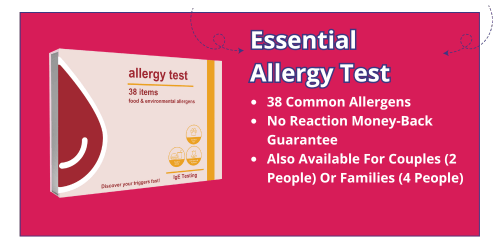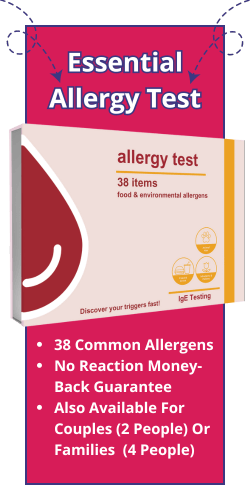Allergy testing has become more and more critical in recent years. With the rate of allergies consistently heading towards the 50% mark within Europe, it’s no surprise. But there can be some concern surrounding the safety of allergy testing. As with most things, there are some risks associated with traditional allergy testing, but the question is still there – can allergy testing cause anaphylaxis?
Could an Allergy Test Cause Anaphylaxis?
As with any exposure to an allergen, the possibility for anaphylaxis is there, but it’s relatively low compared to other minor reactions usually experienced if an allergy test comes back positive.
Let’s put this into perspective. An estimated 20 deaths from anaphylaxis are reported each year in the UK [1] while the odds of being struck by lightning are one in 1.2 million [2]. With the UK population currently standing at around 664.4 million, that makes the average person more likely to become a temporary human lightning rod than being axed by a case of anaphylactic shock.
Death by food allergies is also less likely than accidental death in the European population, according to a 2013 study [3]. The point is, while anaphylaxis can be life-threatening, it’s quite unlikely that you will die from allergy test induced anaphylactic shock.
What is Anaphylaxis?
Anaphylaxis is a life-threatening allergic reaction that is most commonly caused by foods, latex, medication and insect stings. Interestingly, the first documented case of anaphylaxis was in 2641 BC, when a mere wasp sting killed King Menes of Egypt.
The symptoms of anaphylaxis include:
- Red Rash with welts (which is usually quite itchy)
- Swollen throat (or other areas of the body)
- Passing out
- Tight chest
- Trouble swallowing
- Wheezing
- Vomiting
- Diarrhoea
Because this reaction can be fatal, anyone experiencing it needs immediate treatment – usually, an injection of epinephrine (adrenaline) is administered immediately, followed by a trip to A&E.
The risk of anaphylaxis increases if you have a family history of it or have yourself have had and incidence before [5]. The most significant risk, however, is if you suffer from allergies or asthma.
So, What Are the Risks?
That isn’t to say that it won’t happen though. In fact, there’s no way of predicting whether you’ll get anaphylaxis from being exposed to an allergen in any way – whether that’s from a skin prick allergy test, or through accidental ingestion.
The occurrence of anaphylaxis seems to be increasing, though. Between 1992 and 2012, the incidence of yearly hospital admissions for anaphylaxis increased by over 600%, from around 1,150 admissions to over 8,200 per year [4].
Consumption and inhalation are the most likely causes of anaphylaxis, due to the allergen coming into direct contact with your throat and/or lungs. This could explain why the incidence of anaphylaxis during allergy testing Is so low, as it’s typically performed as a skin prick test.
How do they Make Allergy Testing Safe?
Since the risk is present, researchers have suggested that skin prick allergy testing should only take place in places equipped to treat anaphylaxis [6]. So, precautions are made to ensure the patient being tested stays safe throughout testing. The doctor will have an EpiPen to hand and be prepared to respond appropriately should you experience an adverse reaction to any of the allergens being tested.
It’s also worth noting that, very few deaths due to food allergies are reported each year in the UK; on average, less than ten deaths per year are attributed directly to food allergies [7].
How can I Remove the Risk?
If you are still concerned about the risk of anaphylaxis from an allergy test, there are other methods of allergy testing. You can always opt for a blood sample test rather than the traditional skin prick test to determine if you have any allergies. This method takes out the risk of coming into contact with several allergens, which you may or may not be allergic to, and can be much more convenient for many – as the sample can be drawn at home.
References
[1] Nice.org.uk. (2016). Introduction | Anaphylaxis | Quality standards | NICE. [online] Available at: https://www.nice.org.uk/guidance/qs119/chapter/Introduction [Accessed 19 Feb. 2020].
[2] D.M. Elsom (2001). Deaths and injuries caused by lightning in the United Kingdom: Analyses of two databases.
[3] Umasunthar, T., Leonardi-Bee, J., Hodes, M., Turner, P.J., Gore, C., Habibi, P., Warner, J.O. and Boyle, R.J. (2013). Incidence of fatal food anaphylaxis in people with food allergy: a systematic review and meta-analysis. Clinical & Experimental Allergy, [online] 43(12), pp.1333–1341. Available at: https://onlinelibrary.wiley.com/doi/full/10.1111/cea.12211 [Accessed 19 Feb. 2020].
[4] Turner, P.J., Gowland, M.H., Sharma, V., Ierodiakonou, D., Harper, N., Garcez, T., Pumphrey, R. and Boyle, R.J. (2015). Increase in anaphylaxis-related hospitalizations but no increase in fatalities: An analysis of United Kingdom national anaphylaxis data, 1992-2012. Journal of Allergy and Clinical Immunology, [online] 135(4), pp.956-963.e1. Available at: https://www.ncbi.nlm.nih.gov/pmc/articles/PMC4382330/ [Accessed 19 Feb. 2020].
[5] Systemic reactions from skin testing: Literature review.
[6] Pitsios, C., Dimitriou, A. and Kontou-Fili, K. (2009). Allergic reactions during allergy skin testing with food allergens. European annals of allergy and clinical immunology, [online] 41(4), pp.126–8. Available at: https://www.ncbi.nlm.nih.gov/pubmed/19877567 [Accessed 19 Feb. 2020].
[7] Ons.gov.uk. (2012). Number of deaths from food allergies, registered in England and Wales in 2012 to 2016 – Office for National Statistics. [online] Available at: https://www.ons.gov.uk/peoplepopulationandcommunity/healthandsocialcare/causesofdeath/adhocs/009153numberofdeathsfromfoodallergiesregisteredinenglandandwalesin2012to2016 [Accessed 19 Feb. 2020].







